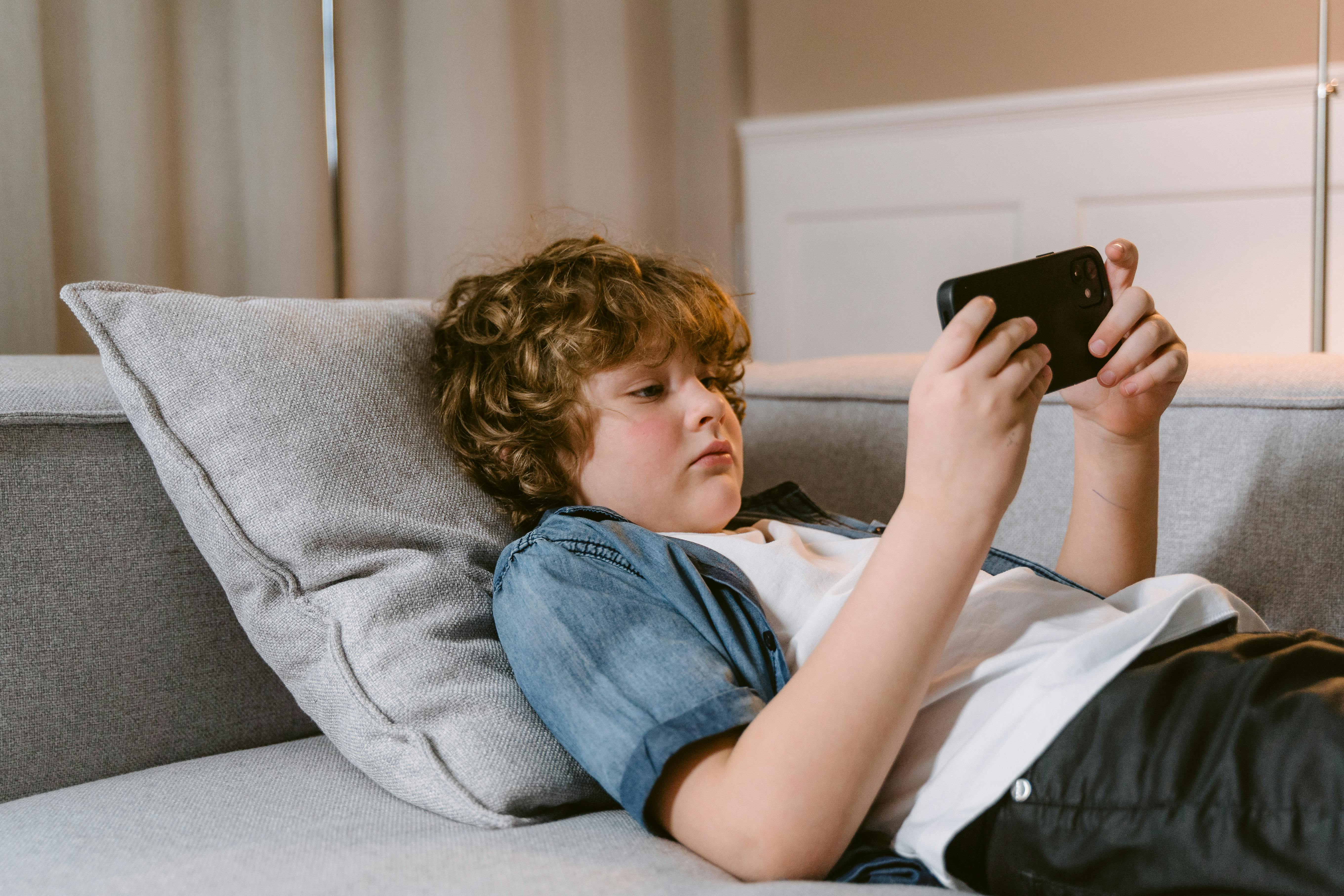For Matthew Tavender, head of faculties at Cunningham Hill major faculties, the issue wasn’t youngsters utilizing their telephones throughout faculty hours; it was the pervasive affect of social media when his pupils left the classroom.
“We had been coping with the fallout on Monday morning”, he defined. “Prior to now ten years that smartphones have been round, I’ve not heard one at school. However what we had been seeing was the injury smartphones had been having exterior of faculty, and the influence of that inside”.
Final Could, his major faculty – together with 32 others in St Albans, Hertfordshire – determined to handle the issue themselves. They despatched out a joint letter to households, declaring their faculties smartphone-free and urging mother and father to not give their youngsters the gadgets till a minimum of the age of 14.
The advantages, Mr Tavender says, have been clear to see.
A check-in earlier than Christmas to evaluate smartphone use amongst his pupils revealed that simply seven per cent of yr 6 pupils have a smartphone – down from 68 per cent the yr earlier than.
“Our older youngsters, who would have had a smartphone however now don’t – their consideration is significantly better,” Mr Tavender says. “There’s a particular enchancment of their relationships. They speak extra, play extra, whereas plenty of our yr 6s (aged 10 or 11) had been fairly sedentary earlier than.”
Analysis from regulator Ofcom final yr discovered that youngsters aged eight to 11 years previous usually tend to personal a smartphone than not, with 59 per cent having them.
As soon as youngsters go to secondary faculty, that is nearly common. At Cunningham Hill Faculties, that they had some youngsters in yr three (aged seven or eight) with their very own smartphones, and this isn’t unusual.

Ofcom discovered that round 1 / 4 of five-to-seven-year-olds have a smartphone. Utilization of social media apps and messaging instruments can be growing year-on-year for major school-age youngsters, and a current YouGov ballot discovered 23 per cent of youngsters aged eight to fifteen spend greater than 4 hours a day utilizing screens.
Earlier than Cunningham Hill took motion, employees had been seeing plenty of the issues coming from WhatsApp, Mr Tavender mentioned.
“That was the largest explanation for bullying and points with friendship within the faculty,” he defined. “WhatsApp teams had been getting larger and larger, some had about 90 individuals in, and half of them weren’t in our faculty.
“The interactions between our kids had been very detrimental on there – numerous inappropriate language, inappropriate footage being shared. Nothing sexual however there have been feedback on violence and race and issues like that.
“We had been having a variety of our yr 6s speaking about Andrew Tate, and definitely a number of the boys revering who he was”.
Twenty years in the past, if youngsters fell out within the playground, they may take away themselves from the struggle on the finish of the varsity day. Now grievances observe them residence by means of instantaneous messaging apps, Mr Tavender defined.
Whereas points generated from youngsters’s social media use have decreased considerably within the first yr of the experiment, they haven’t disappeared fully, he added.
In October final yr, issues cropped up among the many small group of youngsters who nonetheless had smartphones – with mother and father having to be warned about inappropriate messages that had been being shared.

By the point Graham Dill’s 10-year-old son strikes into yr 6 subsequent yr, he’s hopeful that nearly the entire class is not going to have smartphones. “Taking one thing away is rather a lot more durable than not letting individuals have it within the first place,” he mentioned.
As a mother or father at Cunningham Hill who additionally works as a personal tutor, Mr Dill has two completely different views of the influence of smartphones and social media on youngsters.
He tutors youngsters who don’t go to high school; some with behavioural points or who’re too anxious to attend.
Sustaining his pupils’ consideration will be powerful in a post-smartphone age, he defined: “I’m working with youngsters from round 13-to-16-years-old and they’re extraordinarily distracted.
“It impacts their focus and their capability to take some deep breaths and be current on a activity. They want that activity to go proper instantly or need different stimulation whether it is too boring.
“With one boy, it’s a relentless default to take his cellphone out of his pocket and it’s a fixed reminder – no, put the cellphone away.”
When Cunningham Hill introduced to folks that they might go smartphone free, Mr Dill was more than happy. Annually group within the faculty has a smartphone free ambassador to relay data to different mother and father and hold them sticking to the pact.
Mr Dill’s youngsters, George and Thomas, are aged 10 and eight, and he believes that if mother and father get on board when their youngsters are youthful it’s simpler to take care of the pledge to maintain them smartphone free.
“If most individuals usually are not doing it [giving their children phones], then it turns into rather a lot simpler”, he defined. “We’re having this battle in the intervening time with Fortnite. All of them need Fortnite and we [Mr Dill and his wife Rachel] don’t actually need them to play that.
“It’s as a result of their associates are enjoying Fortnite that they need to do it, and I believe that’s the identical with telephones down the road”.
His boys are additionally beginning to recognise the low-mood that may be generated from too lengthy spent on-line. “The comedown is such that they’ll recognise that they’re dysregulated at that time,” he defined. “We’re making an attempt to get them to know when they should come off a tool”.
Father or mother ambassadors on the St Albans major faculties have now set their sights on native secondary faculties, and are hoping to foyer headteachers to push them to take extra motion.
_n_S1_E3_00_25_31_20.jpeg)
Deputy head of Queens Park Group College in London, Paul Drummond, has three youngsters at a secondary faculty in St Albans. Their faculty, Samuel Ryder Academy, permits college students to convey telephones to high school however they shouldn’t be seen in classes, and shouldn’t be used for private use on web site.
At Queens Park, the place Mr Drummond works, the coverage is stricter. Youngsters usually are not allowed smartphones in years 7, 8 or 9. At key stage 4 pupils are allowed them however they’ll’t be seen on the varsity web site. At key stage 5 or A ranges, college students are allowed the telephones, however they shouldn’t be seen and can be utilized in classes solely when the instructor permits it.
He defined: “Since we’ve banned telephones from being onsite at key stage 3, the expectation is that if college students want a cellphone so mother and father can observe them, they need to use an previous Nokia.
“One of many issues with that’s that there will be racial stereotyping of youngsters with previous Nokias, with members of the general public considering they’re burner telephones. A number of the mother and father are very frightened about that.
“However since we’ve banned telephones at key stage 3, the safeguarding points, bullying, and different issues have been decreased fairly considerably,” Mr Drummond mentioned.
“We agonised over banning them. We’ve obtained fairly a big web site and at break time it’s a a lot happier place now there’s no telephones.”
A current survey of greater than 15,000 faculties discovered that 99.8 per cent of major faculties and 90 per cent of secondary faculties have some type of cellphone ban.
Teachers on the College of Birmingham additionally concluded in a examine revealed in February that simply banning smartphones in faculties doesn’t enhance youngsters’s grades or wellbeing, or cut back their general cellphone use.
As a substitute, they argued that any bans have to be a part of a wider technique to decrease cellphone use amongst college students.
As a mother or father, Mr Drummond has skilled the difficulties of making an attempt to scale back the household’s social media use. A plan to don’t have any display screen time collectively throughout the night, and a ban on telephones going upstairs, went out of the window when Covid hit, he mentioned.
-2-April-2025-00-16-01.png)
In his view, limiting cellphone entry needs to be coupled with schooling about utilization for each his youngsters and pupils. His faculty has launched a tutorial each week for the entire faculty on the large new tales of the week, which is instructing youngsters discernment, Mr Drummond mentioned.
“We spent 20 minutes discussing the information story, the place it got here from. We speak about misinformation, reliability and the significance of creating an opinion and political engagement.
“The underside line is that if somebody has entry to the web they’ll have a look at something they need to actually. So we’re making an attempt to get individuals to know the perils but additionally to know why it’s nice to look issues up and discover issues out.”
Ofcom analysis has discovered that youngsters’s engagement with information and present affairs is low and nearly solely by way of social media.
Netflix’s present Adolescence has not too long ago sparked nationwide debate over the risks of youngsters’s entry to digital areas.
The collection follows 13-year-old Jamie Miller whose publicity to misogynistic on-line communities might have contributed to him killing a feminine classmate.
Whereas prime minister Sir Keir Starmer has backed the present being proven in faculties, he has mentioned {that a} government-led cellphone ban is “fully pointless”.
For Mr Tavender, stricter measures from authorities can be very useful.
“If the federal government had been to say we’re banning telephones then it might make it very straightforward to get that message throughout, as a result of that’s simply the way in which it’s”.
He’s towards a “postcode lottery” the place some faculties have stricter measures than others: “It needs to be a nationwide resolution like in different international locations, to ban telephones and social media for kids. From an schooling perspective, we’re crying out for that help.”
Within the meantime, he’s eager to maintain the grassroots motion going and persuade native secondary faculties to ask mother and father to delay giving their youngsters smartphones.
The varsity can be making an attempt to transcend cellphone use and persuade extra of their college students to get exterior, and encourage out of doors play.
Mr Dill feels the identical. Whereas he’s been inspired by the adjustments St Albans major faculties have made, he needs politicians to get on board.
“I believe moderately than backside up it wants to return from prime down, however I assume we received’t see that till we’ve sufficient individuals from the underside elevating their palms and saying they need issues performed,” he mentioned.

